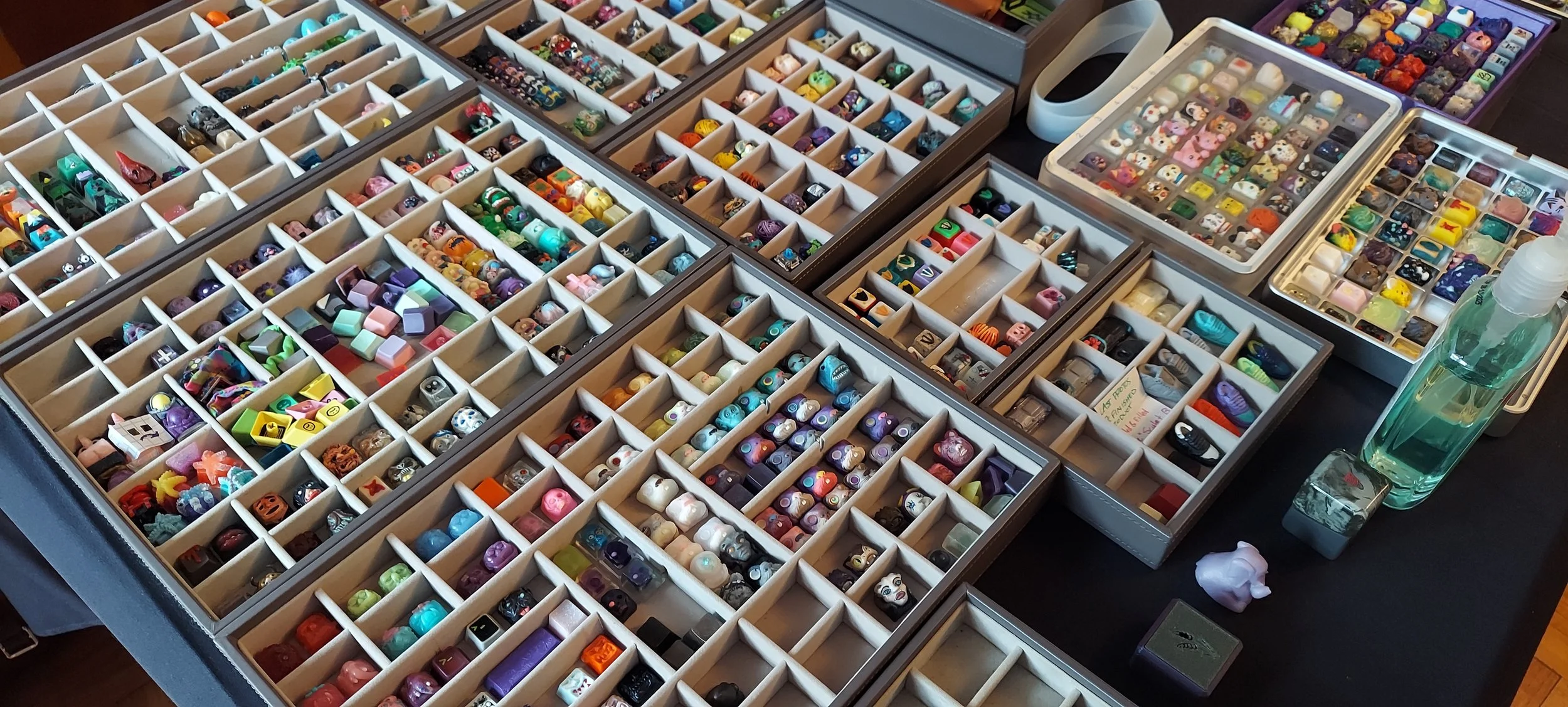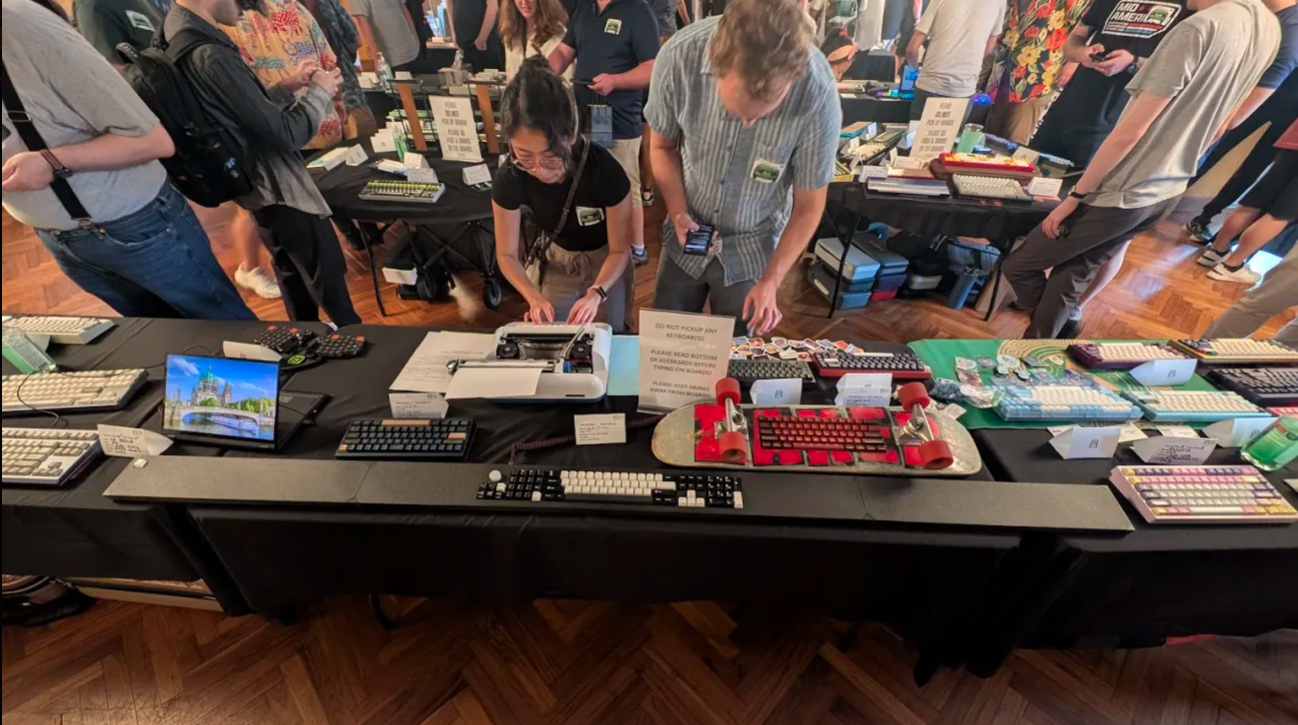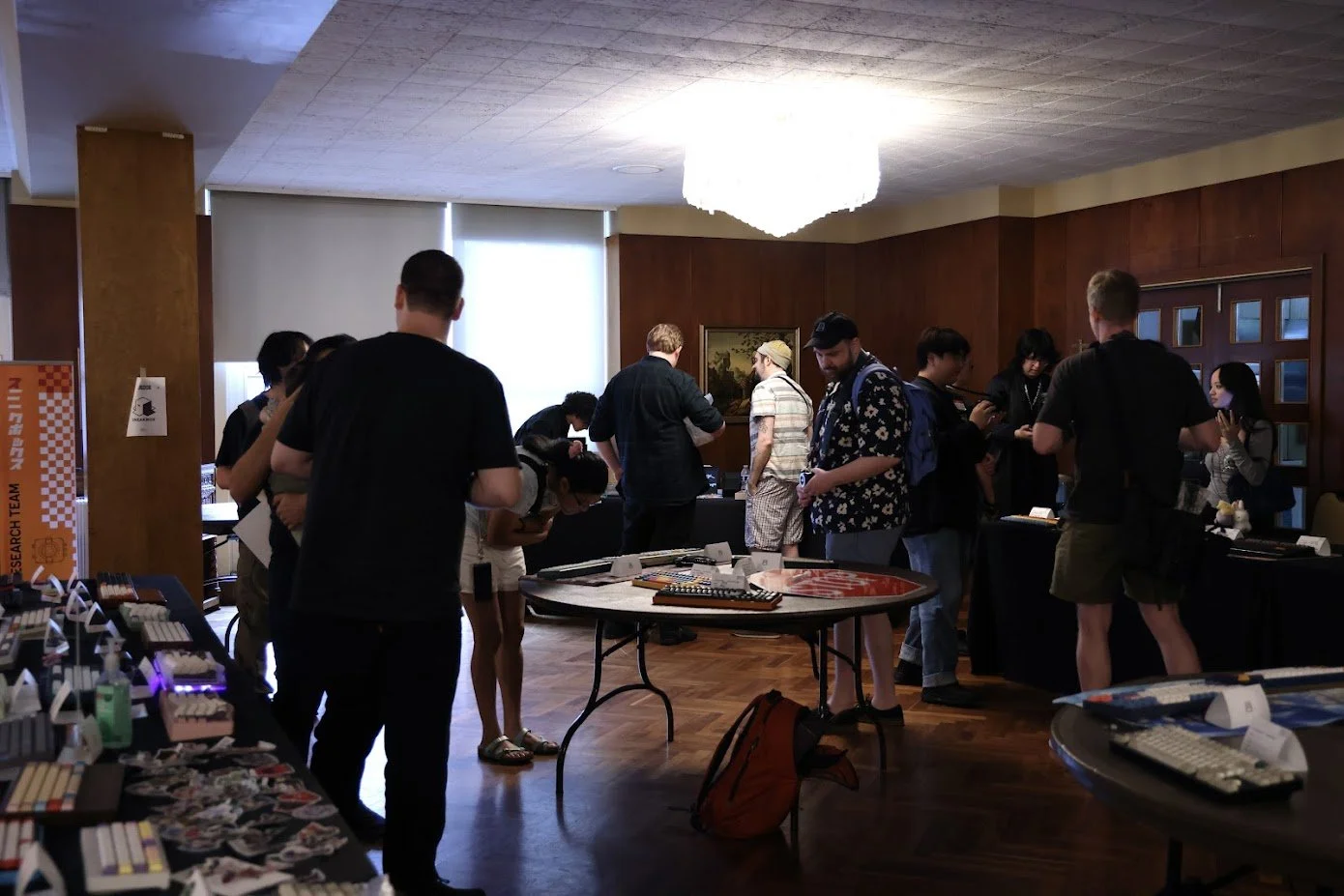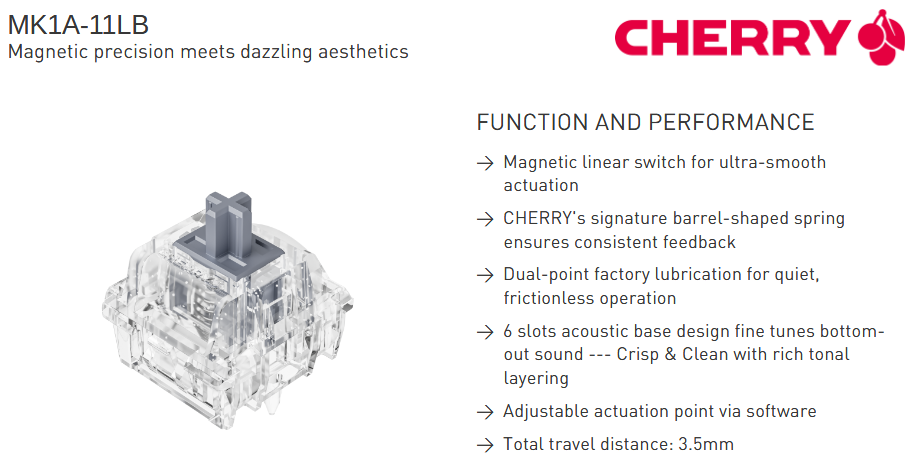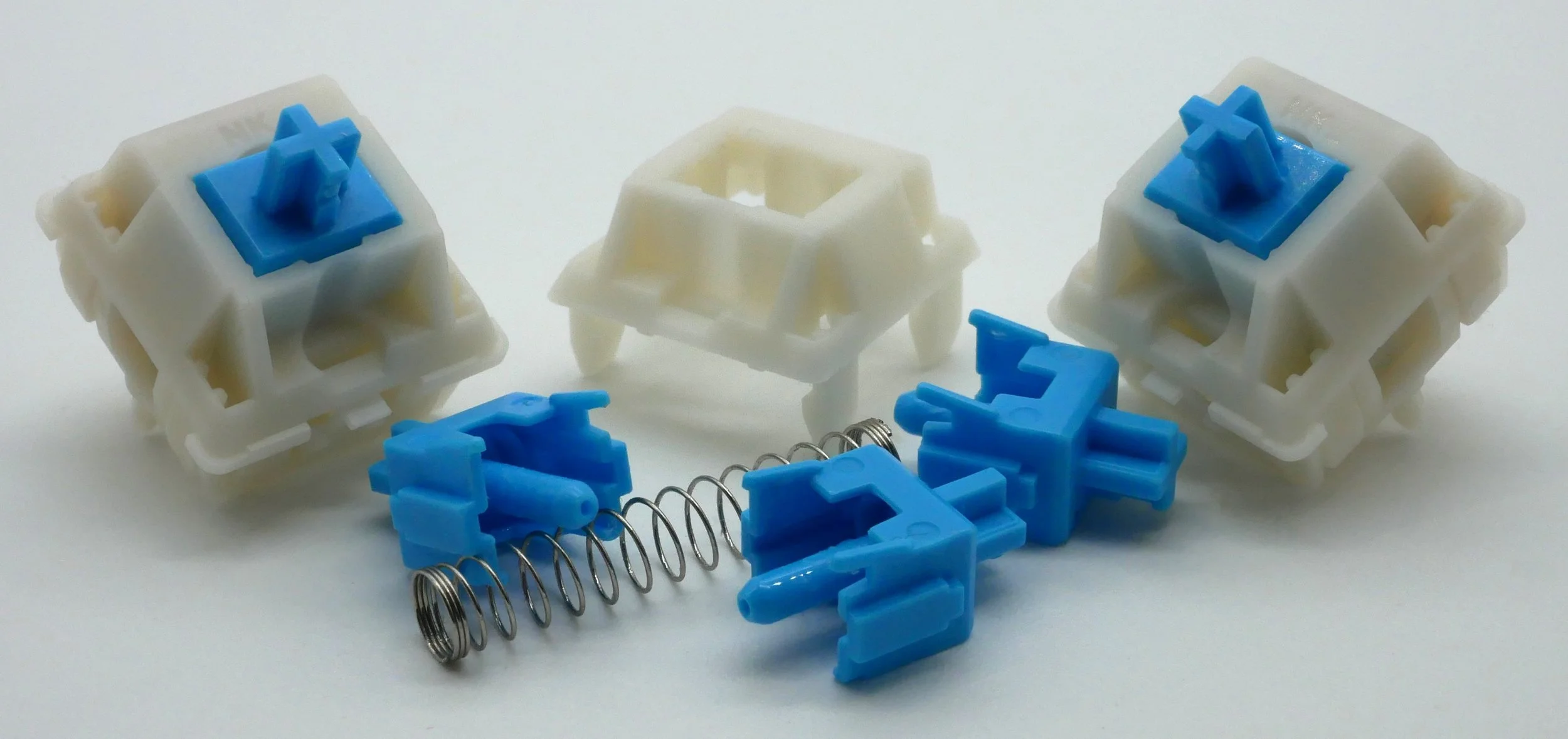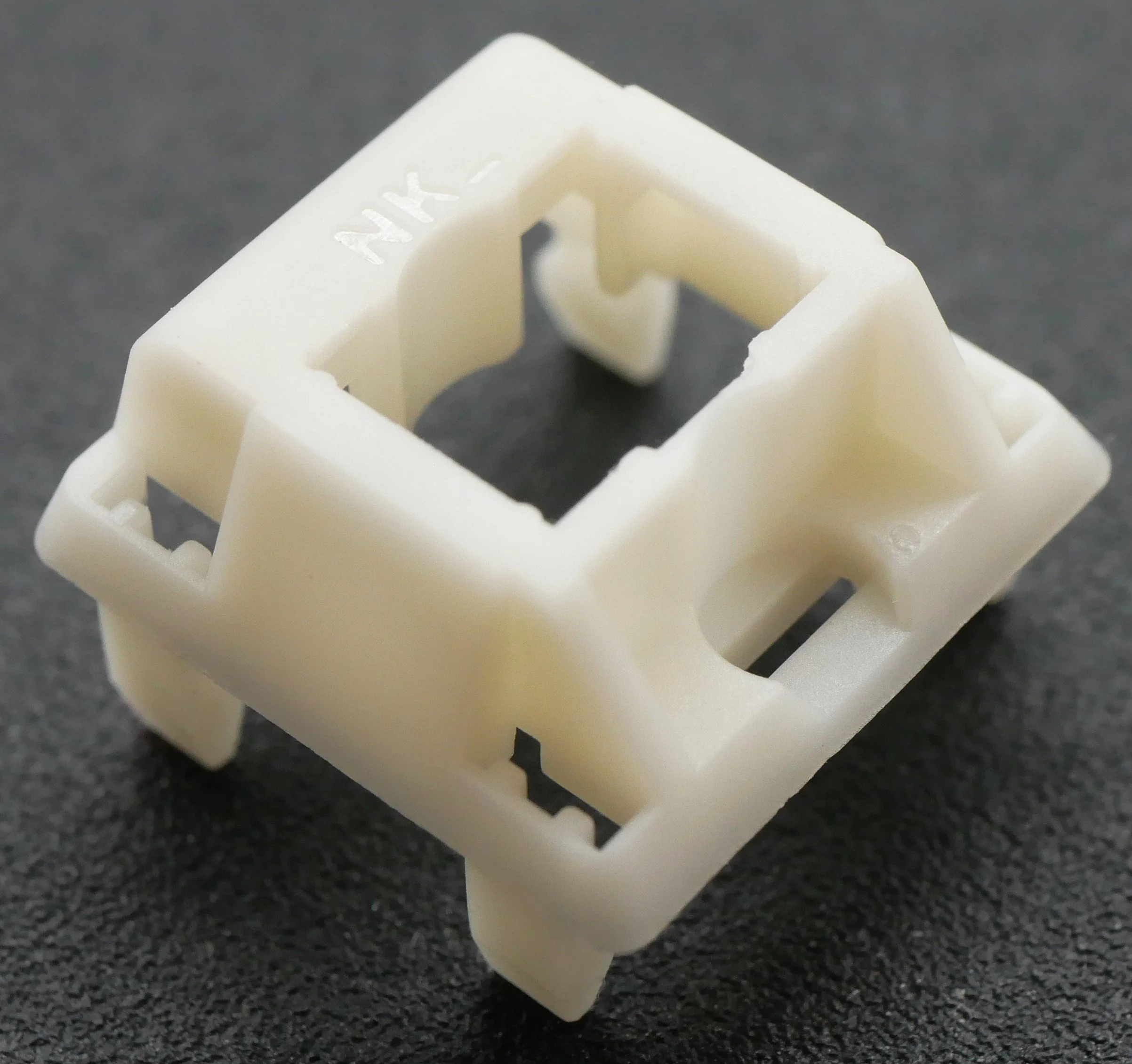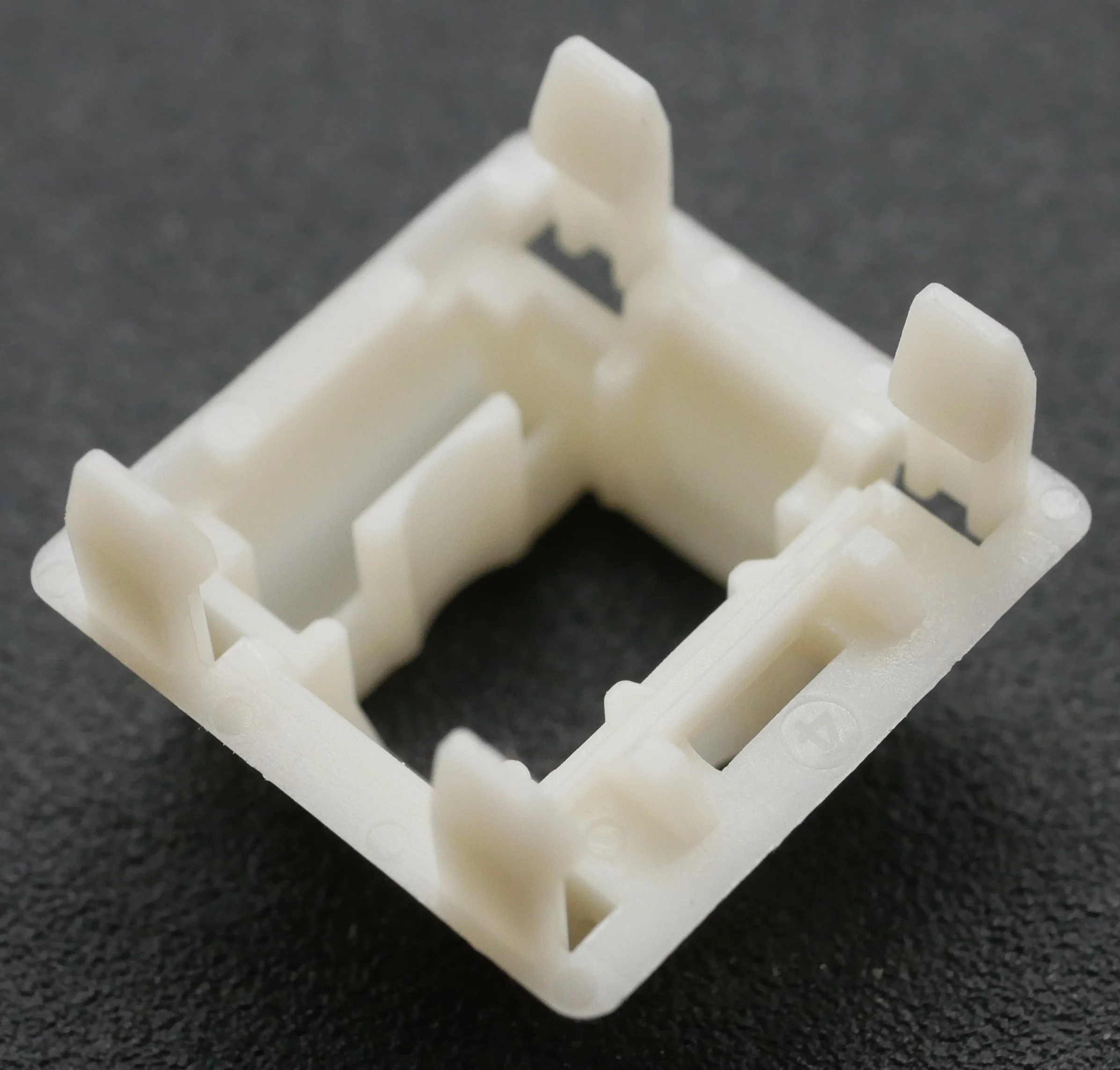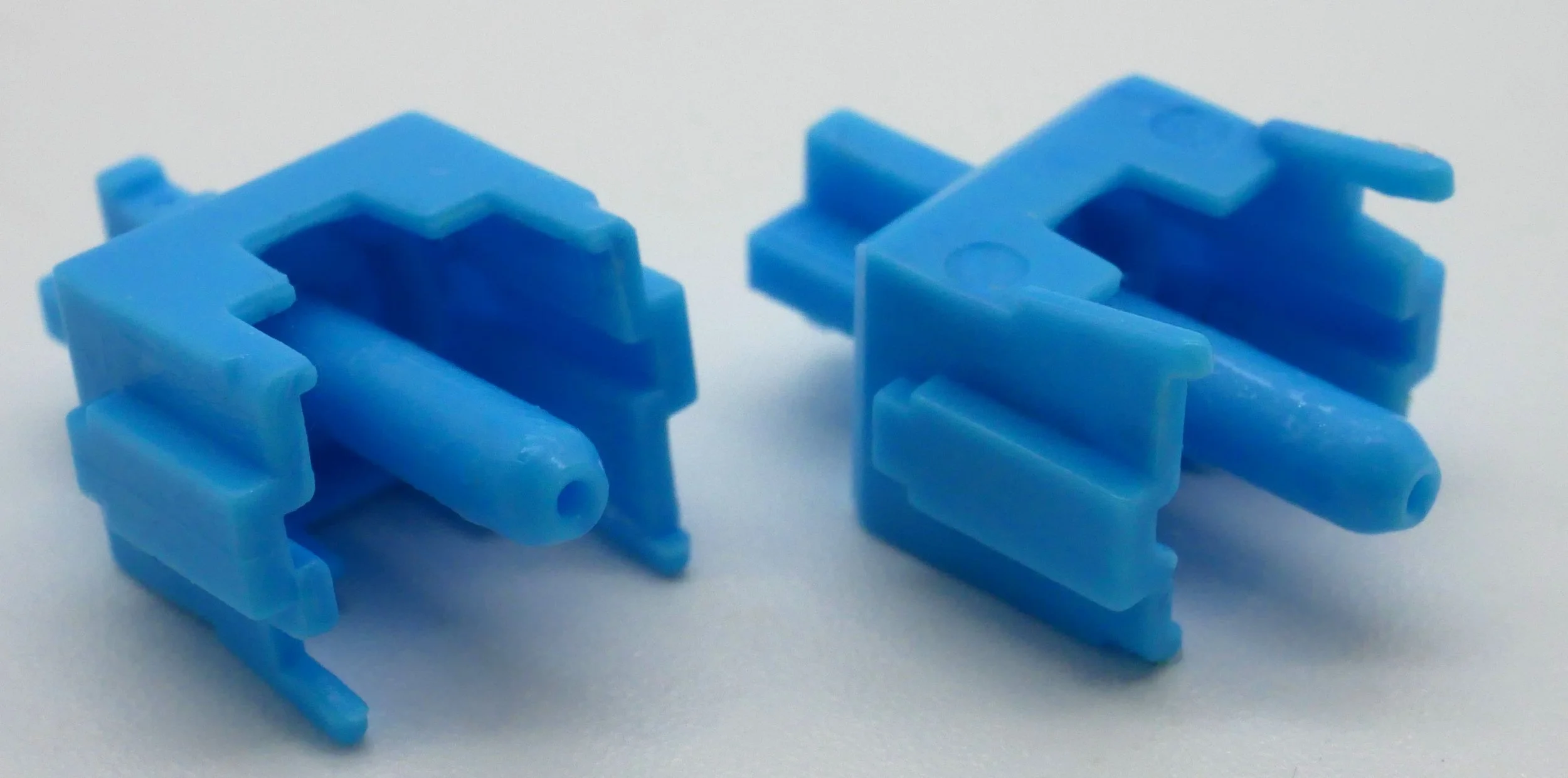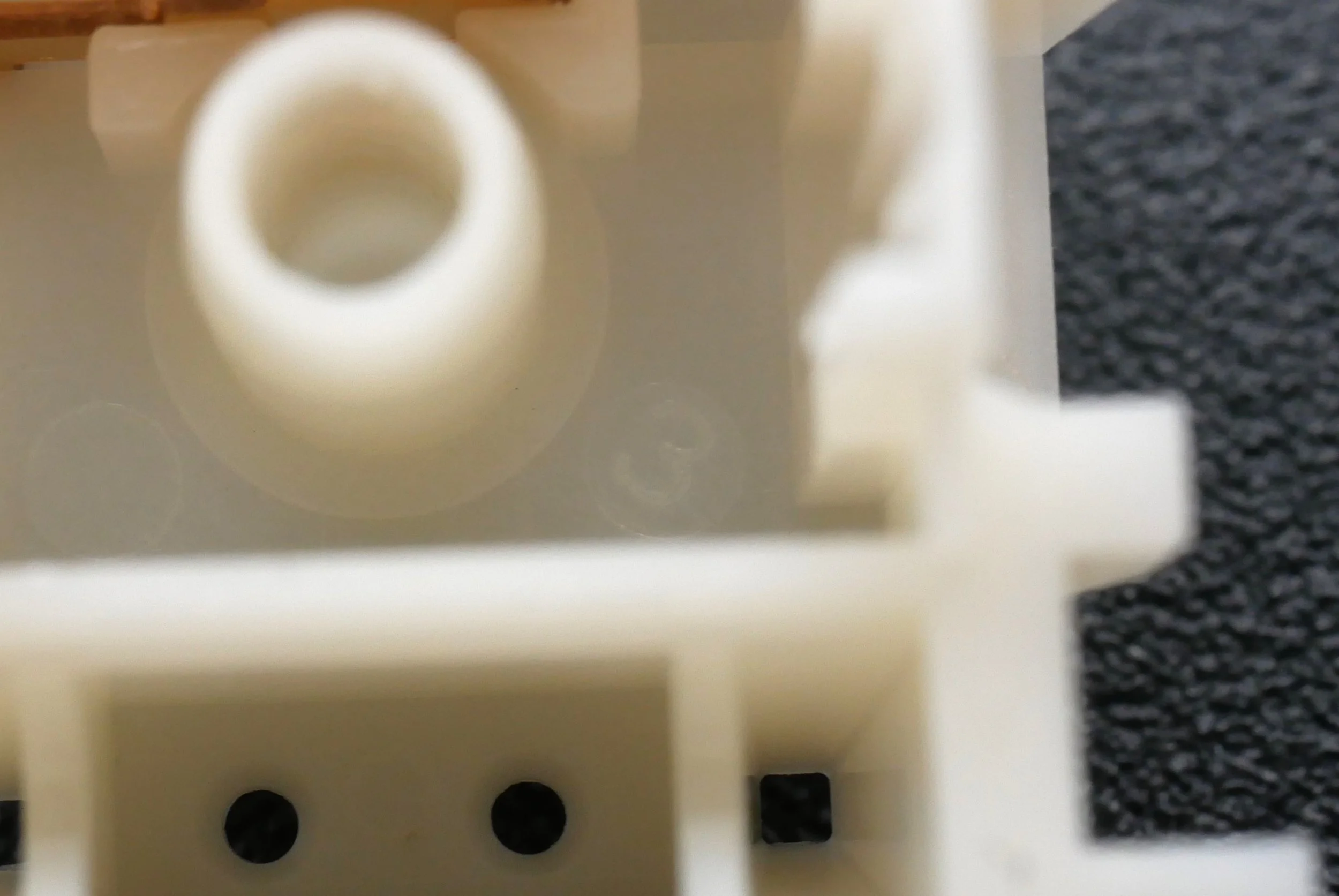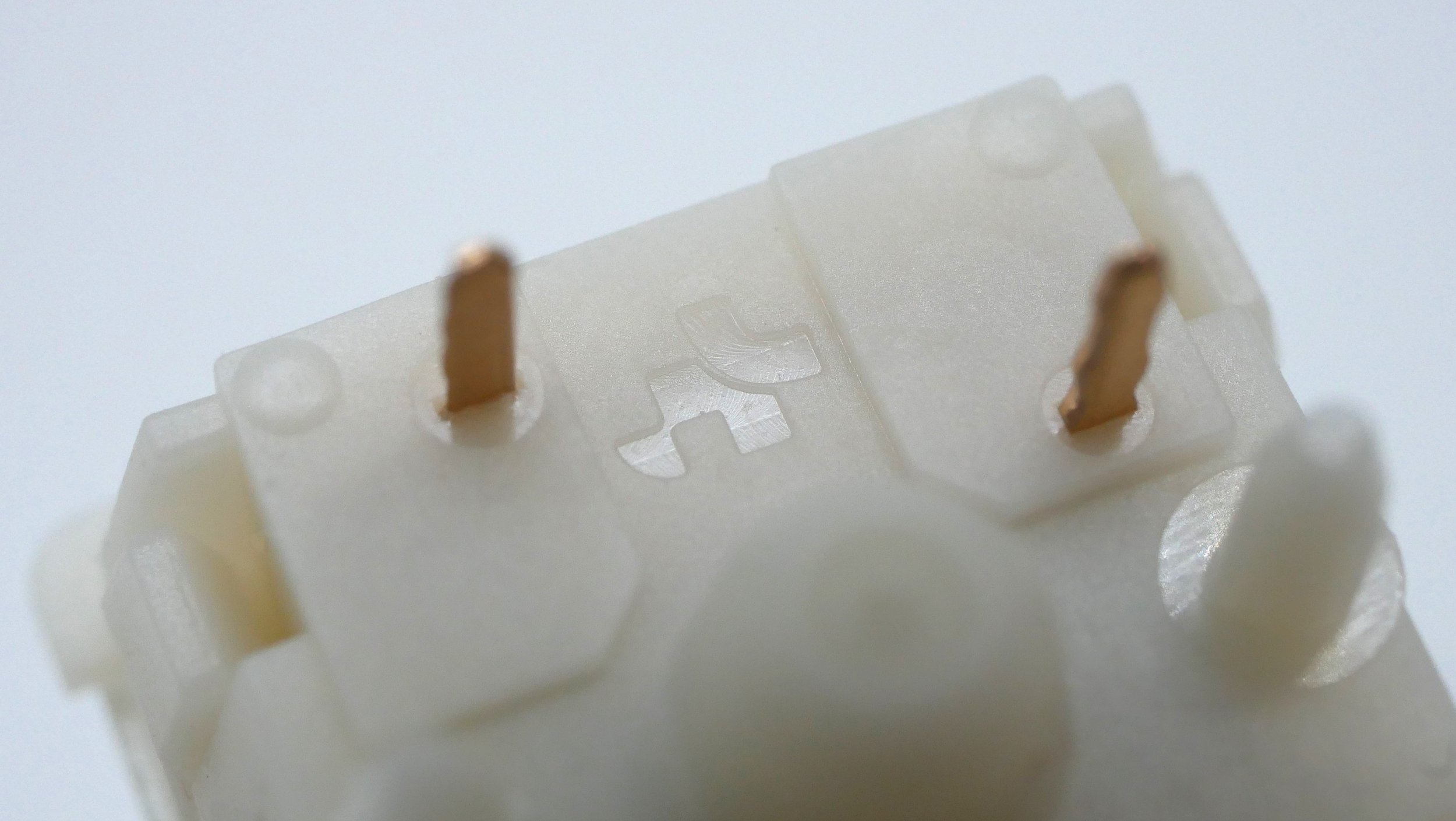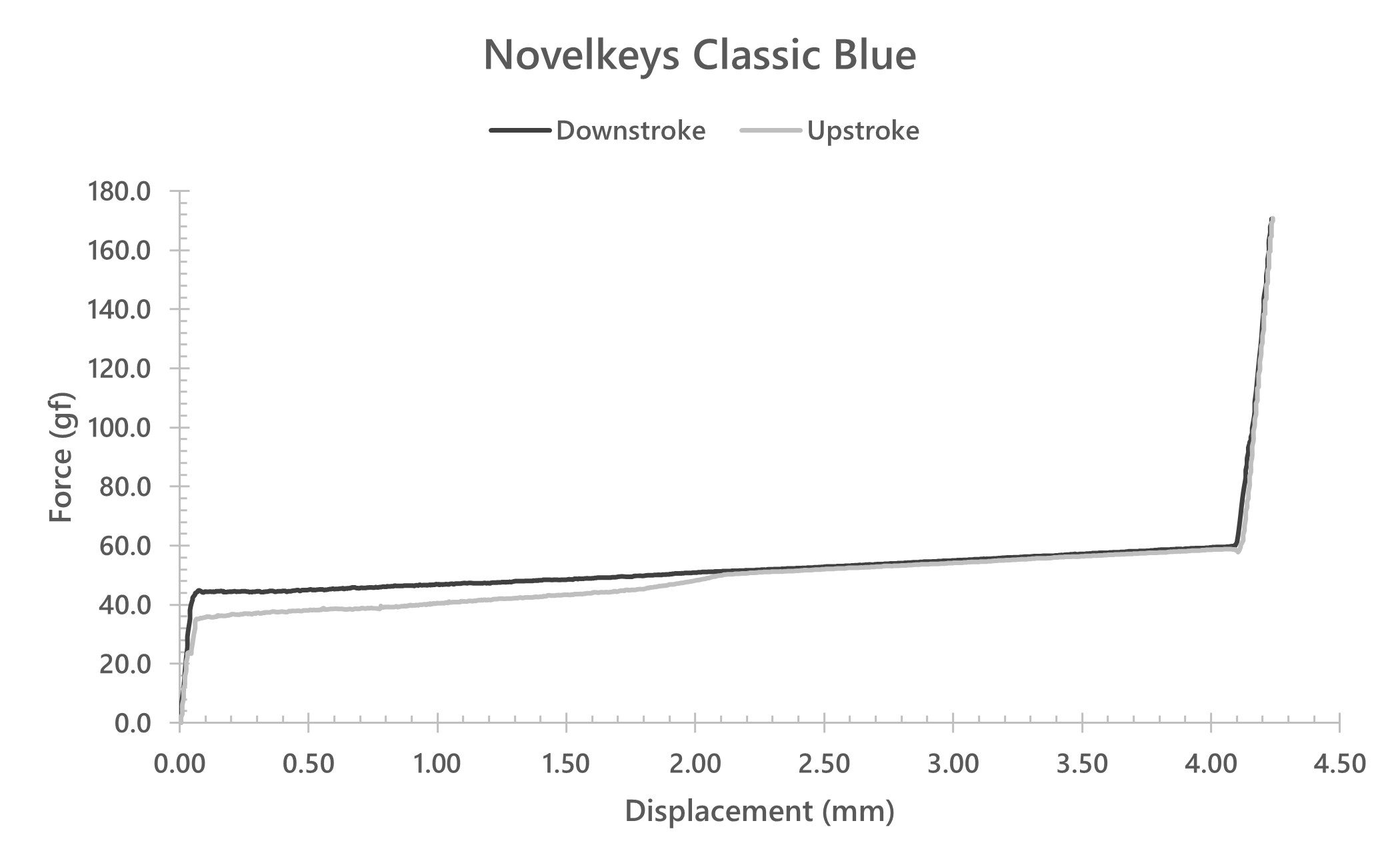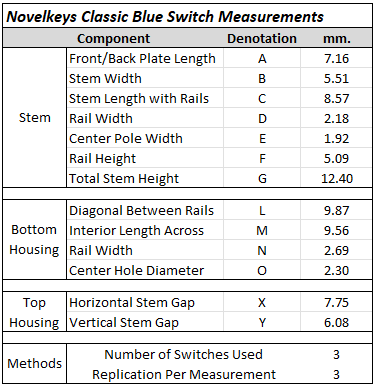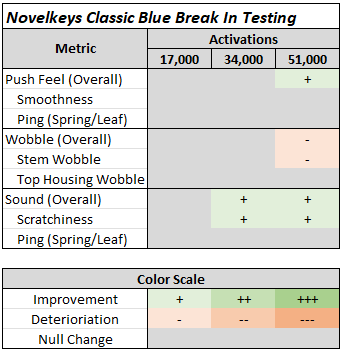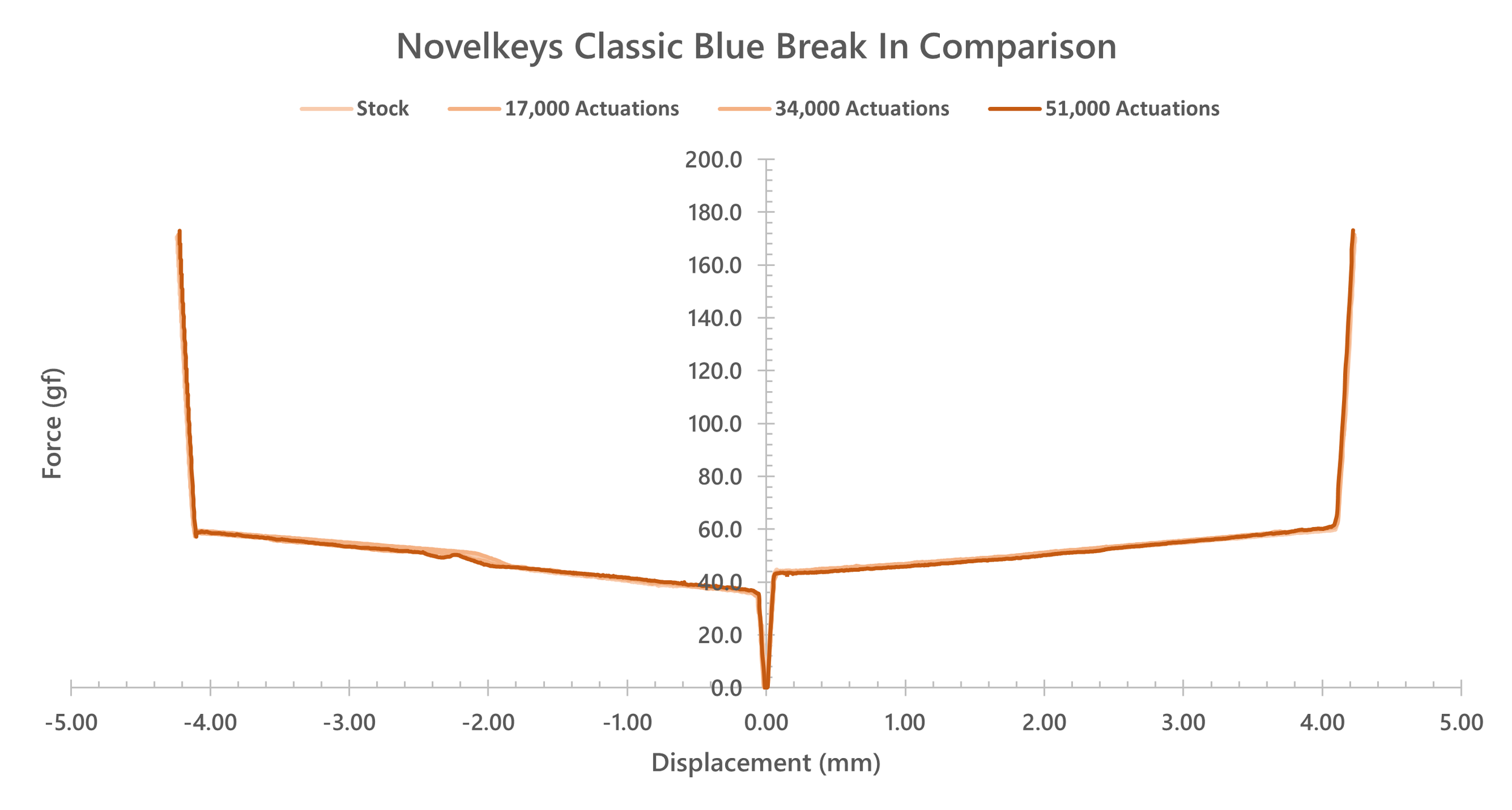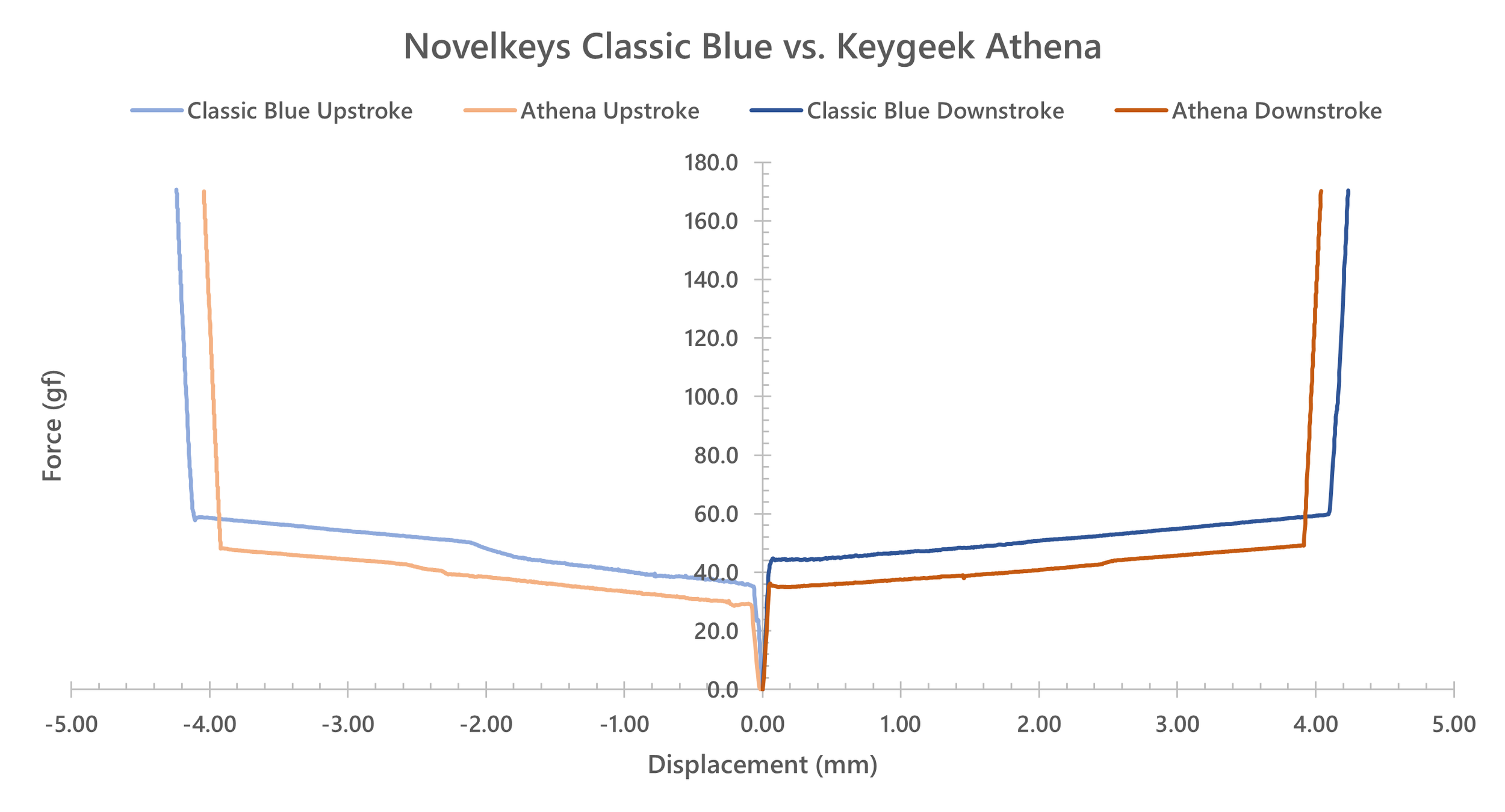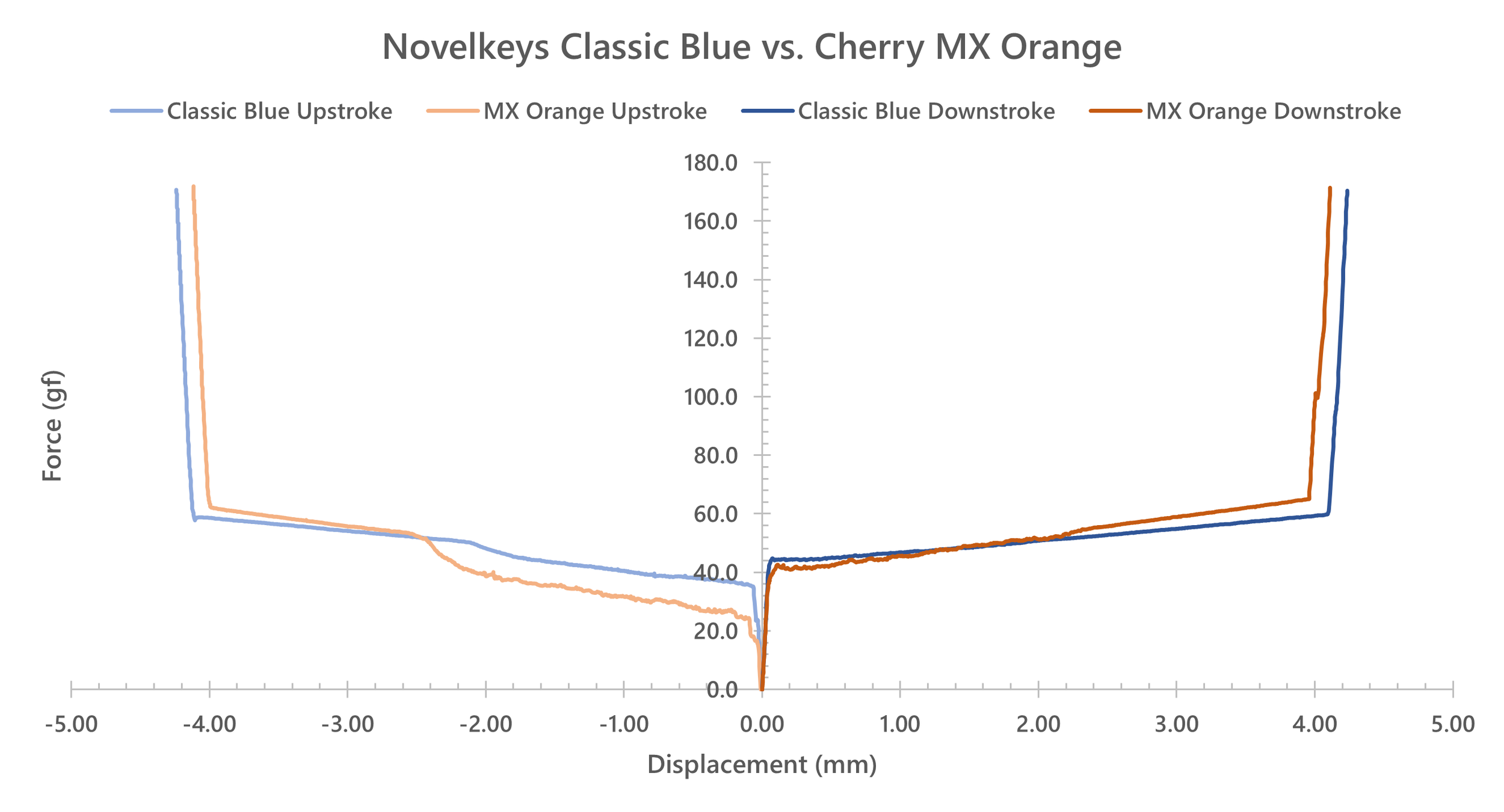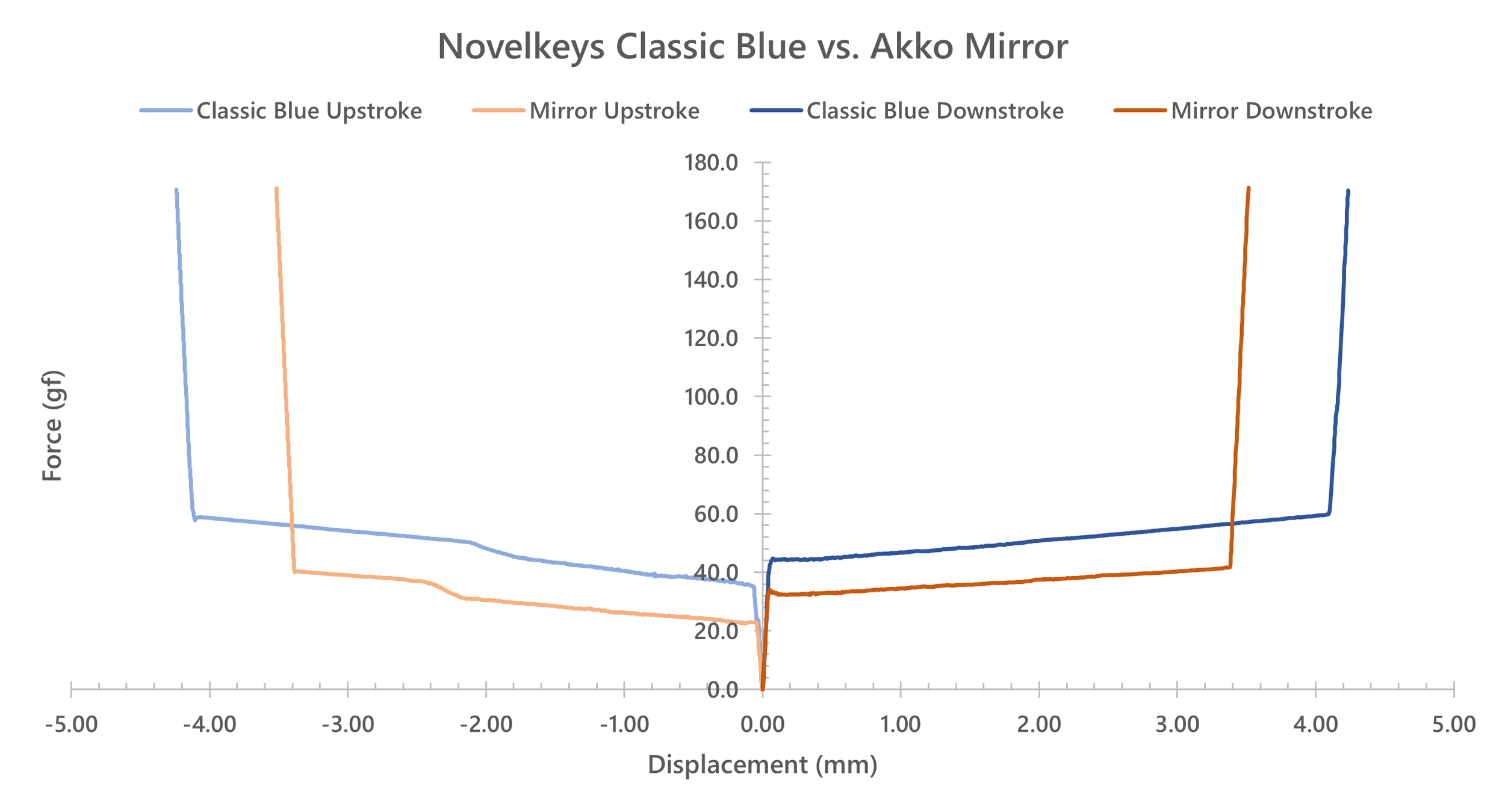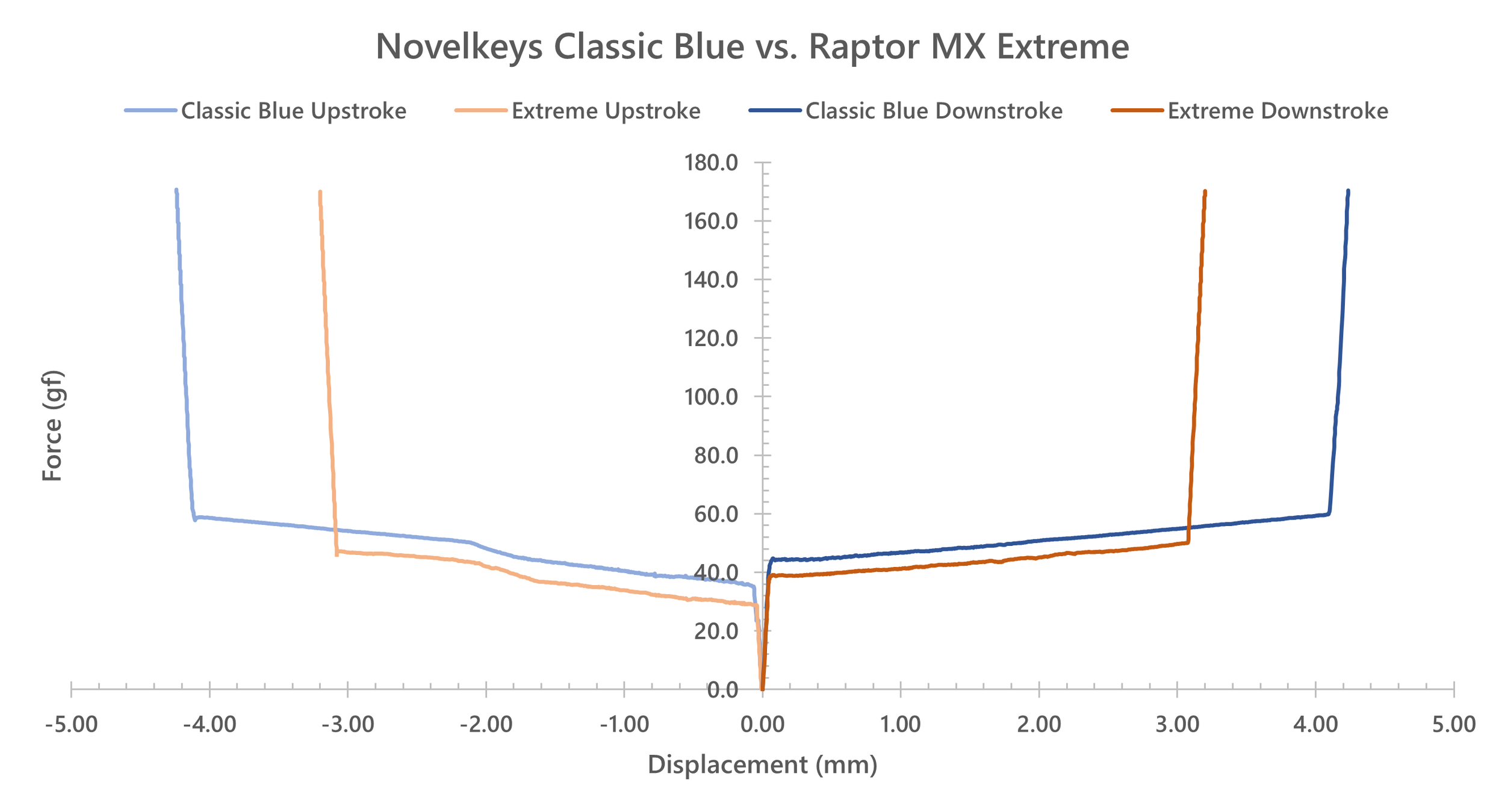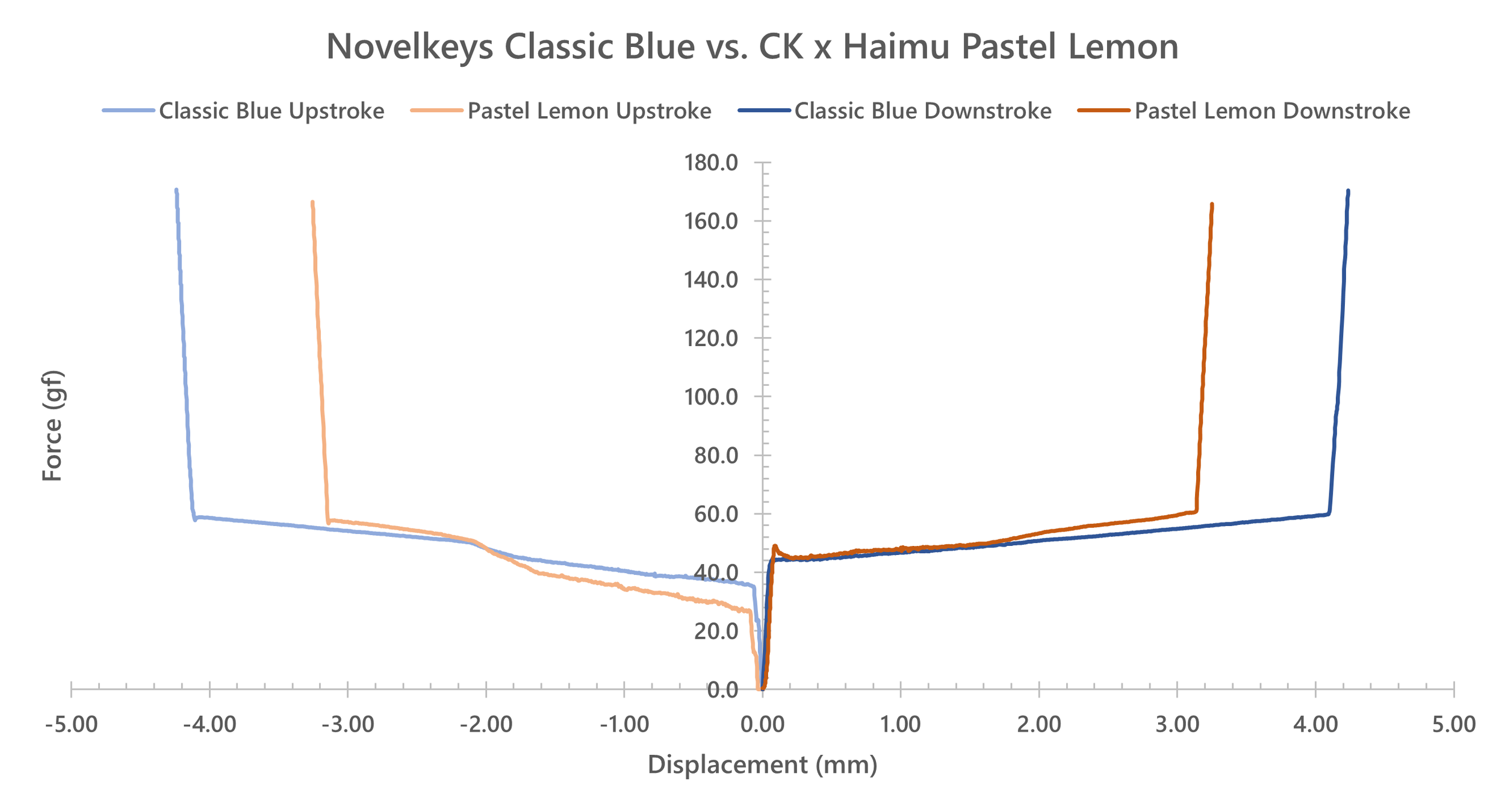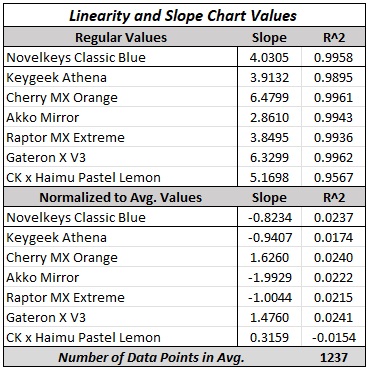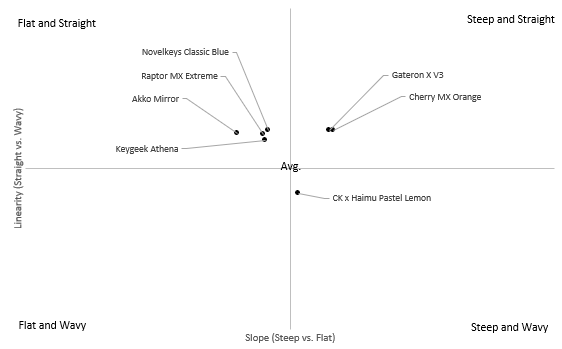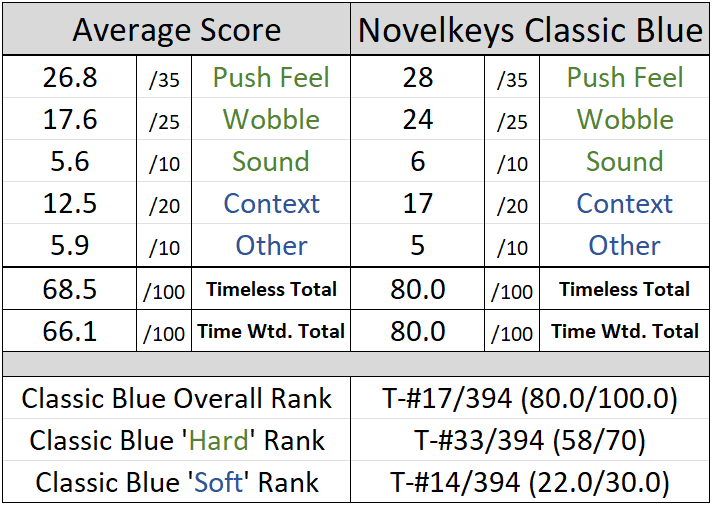Novelkeys Classic Blue Switch Review
I’m starting to wonder if we’ll ever just run out of time at some point in the near future. Like within the next handful of years, I think. I’m not typically predisposed to spiraling through large, overarching existential thought patterns as a result of constantly working on force curves or measuring switches late into the night, but I couldn’t help but be overtaken by these sort of thoughts earlier this week. It kind of does feel this way, no; Like it’s in the air or something. At the much more individual scale I can look back at the last handful of weeks and find myself simultaneously unsure of where I found the time to do everything and wondering how all that time rocketed by me so quickly. This isn’t to imply that this weirdly short-long timeframe has been necessarily negative to any large degree either – a lot of it was quite fun in fact. Chicago’s ‘That Windy City Keeb Meet’ from only a couple of weekends ago was an absolute treat though even that is subject to the same warped perception issue that seems to plague me still to this day. Over the span of eight full hours for the meetup I feel like I talked to at least fifty different people, had an entire panel discussion titled ‘How Consistent Are Switches Anyway?’, interfaced with a dozen different makers and vendors, did some volunteer work, and got some new switches for the collection of it all as well. It was a whirlwind of a keyboard weekend and it was bookended on either side by relatively exciting keyboard work I’ve done between the Keycon 2025 panel talk, the short on the Keyboard Waffle Iron, and even some of the backgrounds of my recent reviews in the Gateron X V3s and Keygeek Athenas. It all just feels so short though despite being clearly packed full. Without anything other than a vague, lingering confusion as to whether or not my grip on time is truly starting to slip out of my control, I’ll roll the tape on some of my favorite sights and photos form the meetup this year much like I always tend to do after they are over.
Figure 1: Yet another time getting to look over JQ's incredible artisan collection.
Figure 2: One of the coolest setups for a board display I think I’ve ever seen at a meetup.
Figure 3: The (not quite setup yet) SwitchOddities table that more or less feels like home to me every time I see it.
Figure 4: Easily the longest and most kick flip-able boards I've ever seen in person side by side in one photo.
Figure 5: What feels like an incredibly well staged photo of Binge and I discussing everything he's been up to lately with HungerWorksStudio. Without a doubt one of my favorite people to catch up with at meetups every year.
Switch Background
Like many of you who read these reviews, I follow Novelkeys on various social media platforms so that I don’t miss out on any of their announcements for new product launches and restocks. And by “products”, I of course mean switches. (I personally have nothing against fun colored Keycult boards except for the fact that I can buy a lot of switches with fun colored Keycult board amounts of money…) In addition to organically coming across the Instagram announcement for the release of the new Classic Blue and Granite switches from Novelkeys on their July 10th, 2025 teaser date, I was also inundated with quite a few pings from friends and fans alike pointing me to this exact post. However, not all of these pings were meant to just flag me down as to the release of new switches. Instead, quite a few of these pings were immediately quick to point out the start of the second sentence on the text portion of this post that states that the Classic Blue and Granite switches are “Manufactured by TYPEPLUS…” Well who the hell is TYPEPLUS? Being unable to answer who this new and mysterious switch manufacturer was, I carried out a quick search online and found them to be a keyboard brand started sometime in the last handful of years by a keyboard enthusiast kevinplus that already had had a few solid collaborations on their relatively short list of work. Prior to their now obvious and very recent attachments to Novelkeys, and thus by extension now the Keycult brand as well, the previous TYPEPLUS engagements included boards designed by both Gok and Ai03 – both fairly discerning keyboard makers in their own right that have a tendency to be pretty picky about who they choose to associate with. Despite being a bit impressed by that initial resume and appearance, though, I was not able to find anything with respect to an injection molding facility, switch assembly production line, or really anything that indicated that they were what I would expect to be called a “switch manufacturer”. So what exactly was the phrase “manufactured by TYPEPLUS” even supposed to mean? I know that I’ve addressed the complexities that might exist out there in assigning origin of creation to switches before in my Red Velvet Switch Review, but at this most recent time this just kind of struck me as having the same sort of feeling as when those budget prebuilt keyboard brands – e.g. Hyte, Razer, etc. – get their switches made elsewhere while claiming that they “made them themselves”. Unlike these various brands, though, kevinplus appeared to be active on Discord. So after a day or so of trying to find any more information about the true origin of the Classic Blue and Granite switches, I said screw it and decided to reach out and ask him directly.
Figure 6: Instagram announcement debuting the launch of the Novelkeys Classic Blue and Alexotos Granite switches.
Figure 7: My original and very direct questions to kevinplus about the origin of the Classic Blues. I'm not normally this direct in DMs so I must have just really had a rough day at work in my defense.
After having reached out to kevinplus with my very direct and pointed questions that we can all judge me for after having seen them above, I initially didn’t receive any answer and went to bed wondering if there would be a response when I awoke. Much to my surprise, the very next morning I woke up to not just one or two pings, but rather eighteen pings on Discord, all of which came directly from him. Dreading that at least a few of these pings may contain insults hurled my way for my bluntness in asking this question, what I instead found upon clicking into our conversation was nearly two pages worth of answers from kevinplus that not only addressed my direct questions but gave a broader picture of the switch landscape as a whole as it presently exists in China. This landscape, I should say, is one that is very different than what I and quite a few of you reading this likely have in our heads here in western countries. To me, as well as I’d argue the majority of people in the western keyboard market, switches are thought of as being developed from the ground up, with mold designs, injection molding, and the assembly of various switch parts all being done under the umbrella of one manufacturer with one very large production facility. This idea is very similar to how Cherry used to produce switches in Germany for the decades and decades prior to their patent expiration. By extension we largely tend to associate this sort of behavior with other, larger established names like Gateron, Kailh, Outemu, TTC, and quite a few more as well. Kevinplus put it rather nicely when they pointed it out to me that this sort of large, vertically integrated switch manufacturer idea just really isn’t as commonplace as we might think these days. While there definitely are still those monolithic titans in the industry that are integrated from mold design to assembly of their switches, the majority of the newer and smaller switch manufacturers as we know them today really only do the assembly of their branded switch parts. In some instances these assembling factories may also do their injection molding as well, though that is more so the exception than the rule. These separated plastic injection facilities or mold machining houses aren’t just working for those one assembly lines either, they too are often taking on work from other switch manufacturers on a run by run basis, causing molds made at one factory to potentially end up in not just one or two, but even a half dozen different injection molding facilities and then by extension even more assembly facilities. Based on what kevinplus shared as well, this is not just something that is slowly happening either – it’s actually becoming increasingly accelerated on the backs of specific companies choosing to focus down more into Hall Effect style switches or just classic MX mechanical style ones. Even some well known manufacturers are also taking the occasional ‘short cut’ by all means and engaging in this sort of piecing and parting out of their production line, and it’s far from a secret in China…
Figure 8: Do these look strangely similar to Outemu Hall Effect switches to anyone else? I'm just asking the question completely unrelated to anything else going on in the paragraph before this image.
As for these TYPEPLUS backed switches that I specifically reached out about, they fall into this new sort of “combinatorial manufacturing” paradigm that kevinplus shared with me in his responses. While the TYPEPLUS team itself is made up of a handful of dedicated people based in Shenzhen, these people are not running a switch factory that makes their own molds, injects their own plastic, and assembles all of their parts together under one roof. According to kevinplus, the molds for both the Classic Blue and Granite switches were thoroughly designed from the ground up by the team with many iterations and rigorous design planning that started in Spring of 2024 and stretched until they had came across a design which had “excellent injection quality and tight tolerances – something that we [TYPEPLUS] consider non-negotiable”. (I should note as well that he also said quite a few of my reviews were used as reference material during this development cycle as well, which makes me I think partially to blame for any issues I have with the switches below…) These housing and stem mold designs were then machined by a chosen facility, making sure to include TYPEPLUS logo on the bottom housings to help distinguish them from any competition, and taken to a separate injection molding facility to be turned into switch parts. Potentially using the same factory that had done the injection molding for the TYPEPLUS stabs released some time ago, the top housing molds were then filled with a custom blend of nylon and other plastics and the stem molds were filled with POM to produce containers of loose switch parts. Finally, all of these parts were shipped to the final TYPEPLUS facility for assembly – the only leg of the production process which they did internalize and develop a setup for. (It was also shared by kevinplus that TYPEPLUS developed their own factory lubing assembly line as well for this part.) That’s the path of these switches. This is what the phrase “manufactured by TYPEPLUS” means. Not just one facility, but rather three separate ones all working in lockstep to produce one single switch all while simultaneously working on releases for other brands in parallel. After having pointed out to him that the statement of these switches being manufactured by TYPEPLUS and all of this new knowledge of their creation still doesn’t really square with my now rapidly antiquating view of how you would assign origin to a given set of switches, his reply was rather simple and put more kindly than was definitely deserved on my part: “If people think it shouldn’t be marketed as being manufactured by TYPEPLUS, I don’t mind. People are entitled to having their own opinion… I just like making new things.”
I suppose I have nothing but respect for the sentiment.
Directly putting center stage the fact that this means these “manufactured by TYPEPLUS” switches were actually more like “manufactured by three production facilities in a trenchcoat claiming to be TYPEPLUS”, it opens the door for the same sort of existential thinking that I demonstrably do not handle well as per the start of this article. How will switch ‘manufacturers’ ever be tracked in the future if two adjacent switches from any given brand could have had their molds made in two different facilities, had their plastic injected in two separate facilities, and then potentially shuffled to entirely different final assembly points? Are my Cherry switches even Cherry? Are any switches from a manufacturer even technically from them anymore? If you’re the kind of person more prone to abstract conspiratorial thinking, it could go as far as to raise the question as to if the concept of a manufacturer even exists anymore. I’m really not entirely sure what to do yet with the paradigm of combinatorial manufacturing. I suppose that it would be interesting from a larger documentation perspective to try and start denoting switches that are truly “single origin” as opposed to made in one place and combined and shipped out from another, if such a thing would be even possible to know. Stepping back from the writing desk for a minute, this also implies a whole new swathe of things for mechancial keyboard consumers as well and I’m not entirely certain that it is necessarily a fully bad or fully good thing either. Sure it makes my personal life incredibly difficult trying to keep track of all of these things, though if it’ll net us all some more unique and well developed switches that increase the variety of experiences that we can have in our keyboards then who am I to complain? However I do choose to address this change moving forward, though, is something that will have to wait for another day. All I can say for certain is that the Novelkeys Classic Blues will stand right at the solid line drawn in the sand as for the point in time that I need to really start actually considering such a paradigm on switch manufacturing.
Bringing it all back down to Earth for a bit, or at the least until the very end of this review where I’ll inevitably spiral back out again, the Novelkeys Classic Blue switches were first released on July 10th of 2025. “Manufactured by TYPEPLUS” in collaboration with Novelkeys and Alexotos, both of these switches were linears with the Classic Blues coming in heavier at a 63.5 gf. of bottom out as opposed to the Granites at a weight of 55 gf. Available in boxes of 36 at $17 per box (or ~$0.47 per switch), these were initially only released in factory lubed variants that utilized TYPEPLUS’ proprietary factory lubing line. However, subsequent restocks of these switches starting on July 30th and beyond found both to be avilable in both lubed and unlubed varieties. While the general freshness of these switches, like most everything I review on this website, makes it hard to estimate their longevity or staying power in the community at large, I suspect that these will be around for quite some time to come. On the Novelkeys end of things, they teased these switches briefly multiple times over leading up to July 10th and also have a history of supporting their branded switches for many, many years at a time with little to no hesitancy in re-upping on stock. As for TYPEPLUS, while they are obviously newer and less established than Novelkeys, brief searches through their Discord server reveals that they have interest in producing more switches beyond just these, have trialed manufacturing housings with different materials than those used in the Classic Blue and Granite switches, and have no qualms about trying prototype batches of anything. Combining these two together leads me to believe that we’ll continue to see and hear about these switches for many years to come.
Classic Blue Performance
Note: This specific review covers Novelkeys Classic Blue switches which have TYPEPLUS factory lubing. While I would have opted to compare both lubed and unlubed options for the purpose of this review, the unlubed options were not put up for sale until after I had already ordered these switches and begun the writing process.
Appearance
At the highest level, the Novelkeys Classic Blue switches come with blue colored stems nestled in opaque, cream white top and bottom housings that truly do make them feel like they belong in the broader family of Novelkeys-backed switches. I can’t exactly tell if it’s the fact that this color scheme is identical to the one Novelkeys is currently using on it’s website or the fact that these could be mistaken for a Dream Cream frankenswitch from far enough way that is leading me to say this, though the design similarity is unmistakable either way. Or it could just as easily be the fact that these feature ‘NK_’ nameplates that are pretty clearly visible. Their release partners in the Alexotos Granite switches are a little bit more distinctive in that they have translucent top housings and grey bottom housings that are different from other Novelkeys releases, though one could easily be confused about those switches as well, assuming they thought them to be another round of Gateron X releases. All things considered, despite the similarities that the Novelkeys Classic Blue switches share with their other historical releases from a distance, up close these are very clearly different from top to bottom. That being said, though, all of these distinguishing features occur at the sub-part level. As a result, discussion of these key features may be found in the paragraphs and photos below.
Figure 9: Novelkeys Classic Blue switches and their components.
Looking first to the opaque, cream white nylon blend top housings of the Novelkeys Classic Blue switches, these are the most similar to existing switch designs of any of the parts of the switch. Or at least this is what appears to be the case outwardly, knowing full well that these were stated as being designed from scratch. The ‘NK_’ style nameplate has been seen on a few releases from Novelkeys in the past. Tight rectangular LED slots that exist only inside of centered circular indentations in the LED/diode slot region have been around a fair bit as well. Even the ribbed gaps over the attachment pins are something that I recall having seen before as well, just maybe not recently or in combination with the previous two features. The only actual feature of the top housings that I cannot recall if I have ever seen before is that of the internal mold marking located on the outer edge of the LED/diode slot in the form of a number in an indented circle. Part of me feels like I have seen this before, though the fact that I can’t mentally pin down exactly what switch it would be that shared this same location makes me think that I may be wrong on this point. I keep coming back around to a Keygeek switch or maybe something that AEBoards released, but I honestly just can’t recall it. (Or maybe this is a sign that all of these switches actually come from the same factory!) Regardless of this, all of these features in combination is not something I recall having ever seen before which supports their claim of being designed from the ground up.
Figure 10: Novelkeys Classic Blue top housing exterior showing 'NK_' nameplate, rather restricted LED/diode slot, and 'ribbed’ gaps above the bottom housing attachment pins.
Figure 11: Novelkeys Classic Blue top housing interior showing the inverted, circle-bound numerical mold marking on the outer lip of the housing and basically nothing else because there wasn’t much for me to say about the interior of these housings.
Moving next to the blue POM stems of the Novelkeys Classic Blue switches, this is where we begin to see some of the new, interesting design quirks of a TYPEPLUS designed switch show up. The first details which jumped out at me right of the gate were the squared-off capes on both the back and front plates of the stem. While this sort of squared off cape is rare enough to find in modern MX style switches already, save for those made by Cherry, seeing these on the front plates of the stems are not something I recall having seen in awhile if ever before. Further inspection finds mold ejector circles on the front plate and non-tapered slider rails like the conventional stem design, though closer inspection points to one particular feature which caught me equally as off guard as the squared off front plate – the very bottom edges of the backside of the stem have their corners carved away. While I’m not entirely sure what taking a little nick out of this portion of the stem is intended to do with respect to the overall feeling of the switch, it is interesting to see it present, nonetheless. Further inspection finds an equally questionably functional feature show up in the form of the stem pole of the stem having a hole in the base of it. Again, I fail to see how this would do anything other than maybe decrease the surface area for contact during bottom out. However, the fact that there is a hole there would lead me to believe that factory lubing could get caught in it, only to slowly ‘wiggle’ out under the force of normal typing over time. How this would or even could be beneficial is beyond me. Inspection of the stems did not find any intentional factory lubing near this hole, though, with only a thin coating existing on the front plate, back plate, and two slider rails of the stems.
Figure 12: Front and back sides of the Novelkeys Classic Blue stems showing the squared capes on front and back plates, non-tapered slider rails, hole in the stem poles, and small 'nicks' out of the backplate corners near the base of the slider rails.
Finally arriving at the matching opaque, cream white blended nylon bottom housings of the Novelkeys Classic Blue switches, these straddle the line between the top housings and the stems when it comes to complexity and density of new features. Internally the housings are fairly simplistic, featuring slightly ribbed slider rails, an internal base of the housing that is level from wall to wall, and not even a south-side spring collar to be found. The leaves are also unadorned and only feature a slight necking in just before they broaden out to their wider leaves for interacting with the switch stems that seems distinctive. The only feature which strikes me as definitely new is the location of the mold marking, which is actually inside of the housings, on the base floor in the form of a single number inside of what would normally be a mold ejector circle. I definitely have never seen mold markings in such a location of a housing before. On the underside of the housings, the Classic Blues come in 5-Pin/PCB mount variety only and are otherwise barren save for a glossy, embossed ‘TYPEPLUS’ logo located upside down between the metal PCB pins. I suppose that it might be worth mentioning that the rings around the PCB mounting pins are also a bit more shiny and reflective than the rest of the housing similar to the logo embossment, though this is mostly just a very fine detail at best.
Figure 13: Novelkeys Classic Blue bottom housing interior design showing ribbed slider rails, barren base of the housing, and slightly necked in leaf at the point where it broadens out to the wider stem-touching portion.
Figure 14: Zoomed in view of the Novelkeys Classic Blue bottom housing internals showing the unique location of the mold markings on these switch parts.
Figure 15: Novelkeys Classic Blue bottom housing externals showing PCB mounting pins and inverted 'TYPEPLUS' logo embossed in between the metal PCB pins. Not emphasized is the reflectance of the rings around the PCB mounting pins and the logo itself relative to the rest of the housing.
Figure 16: An alternative view of the upper portion of the Novelkeys Classic Blue bottom housings emphasizing the difference in texture between various features of the housing.
Push Feel
While there’s quite a few things that can be discussed in the push feeling of any given linear switch, the fact that TYPEPLUS developed their own factory lubing line for these and their siblings in the Granites makes this by far the most critical feature to dive into when it comes to push feeling. On the whole, the factory lubing is a conflicting degree of okay, with both good and bad points to it. The average Novelkeys Classic Blue switch is smooth, plain and simple. It’s not overly lubed to the point that the switch feels gummy or sluggish, though it also is very clearly not a dry or barely factory lubed to any degree at all. It has just enough factory lubing to them that it almost perfectly straddles that middle dividing line between very light factory lubing and overbearing amounts of lube with only maybe a slight bias towards the lighter end than not. The conflicting part about this factory lubing, though, is that those statements can be made about the average feeling and not necessarily how all switches feel. About 15% of the switches in the batch that I received (two bags worth of switches from Novelkeys) demonstrated some differentiability in their smoothness that made them noticeably different from the bulk of the batch though not necessarily unusable at all. Of this 15%, the minority had a very light, sandpapery feeling to them that I suppose could be classified as small grain scratch – something not all that surprising among a batch of lightly factory lubed switches. The remainder of this variant batch, though, had a feeling that I can only best put into words as ‘creaky’. Knowing full well that that sort of word makes infinitely more sense in a sound based description than a feeling based one, the switches that I’m trying to describe here had either dry or overlubed spots at the extreme ends of the downstrokes and upstrokes that gave just enough of a different feeling than the majority of the stroke to give them a texture that feels as if you were rocking a door open and close right on the point where that one hinge is old, a bit rusty, and really needs some WD-40. Despite the uniqueness of this feeling and how much it stands out to me as someone who has tried quite a few linears before, the prevalence in the overall batch is still not all that much, nor does it necessarily preclude some of these switches from being used as is in a build.
Figure 17: Force curve diagram for the stock Novelkeys Classic Blue switch.
Beyond the notes about the factory lubing and smoothness, the Novelkeys Classic Blue switches are otherwise rather standard linear switches and don’t exactly feature much that stands out to any degree at all. The housing collisions, both topping and bottoming out, are well balanced and consistent across different typing speeds, giving a firm and slightly snappy feeling that isn’t aggressive on the fingers but just pushy enough to let you know that they’re there. A feeling that is definitely a bit more lighter than a conventional full nylon style housing, and thus perfectly in line with their descriptions of being made with a ’nylon blend’ material. The weighting and travel distance of the stems feels more or less true to the representative force curve above, which itself is quite straight, quite flat, and about as unassuming as they come for a linear switch. I suppose that it does strike me a tiny bit interested that the separation in force noted in the upstroke from the re-engagement of the stem with the leaf is so weak compared to most other switches out there, though that is something isn’t noticeable in the general usage of these switches at all. If anything it just suggests that the leaves don’t nearly as strongly interact with the stems of the Classic Blues as the leaves of other switches do with their stems.
Sound
I really hate to be reductionist in describing the sound of these switches as ‘simple’ or ‘average’, but honestly I’m just not quite sure I can drum up any fancier way to describe the sound of the Novelkeys Classic Blue switches than that. These are medium volume linear switches that have medium pitched, flat sounding bottom outs and topping outs that are only slightly snappier and higher pitched. They also have a scratch sound in some of them that is more noticeable on the ears than it is under the fingertips, though much like the push feeling above this tone is only in a minority of switches. That’s it. There’s no spring ping, squeaking, loud crashes, car horns, end of regulation buzzers, or anything else unexpected in how they sound. I’m not entirely sure what else can be said to this point. The Novelkeys Classic Blues are ostensibly designed to be “down the middle” linears, they have “classic” in their name, and they use some of the most historically conventional specs that could be selected for a linear switch. There shouldn’t be anything else to them. I’m really not trying to leave this section by hitting the meme of “mmm, yes these keyboard switches sound a lot like keyboard switches”, but using them really does just continually fire something deep in my brain that pushes me to want to describe these as average. They have an average tone, an average volume, and even an average amount of scratch noise that distracts me when typing on them an average amount. I imagine that if you imagine what the most average imaginary linear switch sounds like that it would sound like this to you. (Yes that sentence made it through editing.)
Wobble
In my conversation with kevinplus, one of the things that he made extremely clear to me was that the Novelkeys Classic Blue switches were designed to have such great tolerances on them that there would be virtually no stem wobble. On that point I think the TYPEPLUS team absolutely delivered, as these switches have only the faintest amount of E/W direction stem wobble and not a tiny bit of variation on this metric across the batch that I received. This is above and beyond what could be expected of any company designing their own switches for the very first time for release.
Measurements
If you’re into this level of detail about your switches, you should know that I have a switch measurement sheet that logs all of this data, as well as many other cool features which can be found under the ‘Archive’ tab at the top of this page or by clicking on the card above. Known as the ‘Measurement Sheet’, this sheet typically gets updated weekly and aims to take physical measurements of various switch components to compare mold designs on a brand-by-brand basis as well as provide a rough frankenswitching estimation sheet for combining various stems and top housings.
Figure 19: Numerical details regarding the force curve for the stock Novelkeys Classic Blue switches.
Have you ever wanted to be bombarded with more switch data than you’ve ever seen at any point in your life before? Consider checking out the ‘Force Curve Repository’ hosted on my GitHub that contains all force curves that I take both within and outside of these full-length reviews. In addition to having these graphs above, I have various other versions of the graphs, raw data, and my processed data all available for over 1500 different switches for you to use however you see fit. Check it out via the ‘Archive’ tab at the top of this page or by clicking any of the force curve cards above.
Break In
Break In Notes
17,000 Actuations
- Surprisingly, after 17,000 actuations the Novelkeys Classic Blue switches did not demonstrate any significant changes to their performance relative to that of their stock form. No change in wobble, smoothness, or sound of these switches was able to be detected in hand.
34,000 Actuations
- After 34,000 actuations, the overall sound profile of the Novelkeys Classic Blue switches actually begin to improve somewhat. While the most notable feature is an overall reduction in the outlier noises noted above, chiefly that of the sandpapery, light scratching tones, the batch of switches that was broken in to this degree also simply sounded more homogeneous and uniform than a random sampling of stock switches.
51,000 Actuations
- At 51,000 actuations, the Novelkeys Classic Blue switches finally begin to show some more noticeable degrees of changes over their stock form. In addition to continuing to sound more uniform and less scratchy, the batch of switches also began to feel this way as well. There were overall less inconsistencies in feeling from switch to switch in the batch of Classic Blues that was broken in this far than a random stock batch.
- This is the only stage in break in testing where I noticed any degree of change to the stem wobble of these switches – something which is a real testament to how well designed the tolerances were for the parts of these switches. The increase in wobble was extremely minor at best and equal in magnitude in both N/S and E/W directions.
Figure 21: Comparative force curve diagram showing no substantial change in the force curves of the Novelkeys Classic Blue switches throughout the break in process.
Comparison Notes to Other Notable Linear Switches
Note – These are not aimed at being comprehensive comparisons between all factors of these switches as this would simply be too long for this writeup. These are little notes of interest I generated when comparing these switches to the Classic Blue switches side by side.
Figure 22: Switches for comparison. (L-R, Top-Bot: Keygeek Athena, Cherry MX Orange, Akko Mirror, Raptor MX Extreme, Gateron X V3, and CK x Haimu Pastel Lemon)
Keygeek Athena
- Compared next to one another, the Keygeek Athenas have a much more quiet and overall subtle sound profile than the Novelkeys Classic Blue switches. While I’m not exactly certain as to why this is the case, I believe that this is due to the fact that the Athenas have full nylon housings as opposed to the nylon blend housings of the Classic Blue switches as well as feature a much more generous factory lubing from Keygeek.
- While the Keygeek Athenas are definitely better than the average switch when it comes to stem wobble, they simply don’t stand a chance against the tighter tolerances of the Novelkeys Classic Blue switches. The Classic Blues have substantially less stem wobble in both N/S and E/W directions.
- Despite both switches being smooth linears, the Keygeek Athenas are just a bit less scratchy on average and appear to have less batch wide inconsistencies than the stock Novelkeys Classic Blue switches.
Cherry MX Orange
- Even though the comparative force curves for these two switches below would seem to suggest that they likely feel very similarly weighted to one another, in hand this is not the experience I get at all. For some reason I can’t quite pin a reason on, the Cherry MX Oranges actually feel ‘lighter’ and a little bit more free in their strokes than the Novelkeys Classic Blues. Perhaps this is a function of differences in tolerances between stems and housings between the two switches?
- The Novelkeys Classic Blue switches have a significant amount less stem wobble in both N/S and E/W directions than the Cherry MX Orange switches.
- As could probably be expected, the Classic Blue switches are on the whole a bit smoother than the Cherry MX Orange switches. Yes, this is even keeping in mind the facts that these are among the first switches that TYPEPLUS has ever lubed and that the Cherry MX Oranges are lubed via Cherry’s new MX2A style platform.
Akko Mirror
- While the Akko Mirror and Novelkeys Classic Blue switches actually have fairly similar pitch and tone to one another at bottom out, the Mirrors are just a tiny bit louder and more directly hit the ears than the Classic Blue switches.
- I could imagine that the difference in wobble (or lack thereof) between these two switches is one of those kinds of things that you could ask 100 different people about and get an even split down the middle either way. To me and based on my batches of each that I have lying around, the Classic Blues just barely edge out the Mirrors with less stem wobble in both directions.
- Both the Novelkeys Classic Blue and Akko Mirror switches are on the lighter side of factory lubing for switches, however the HMX-made mirrors are just a tiny bit more consistent and delicate in their factory lubing than the Classic Blues.
Raptor MX Extreme
- The comparative force curve between these two switches below would suggest that there is a rather substantial difference in total stem travel distance that should be incredibly obvious in hand. Surprisingly, this isn’t so much the case. While it’s clear that the MX Extremes bottom out sooner than the Classic Blue switches, they do not feel as if they bottom out an entire millimeter sooner.
- There is a tiny bit less stem wobble in the N/S and E/W directions of the Novelkeys Classic Blue switches than there is in the Raptor MX Extremes.
- Of all of the switches on this comparison list, the MX Extremes are the most different than the Classic Blues in terms of their overall feeling though because of the housing collisions rather than the factory lubing. The rather pointed stem pole bottom outs of the Extreme switches only come across as more aggressive when compared to the softer and definitely less poppy bottom outs of the Classic Blues.
Gateron X V3
- Of all of the switches on this comparison list, the Gateron X V3s are the ones which sound the most similar to that of the Novelkeys Classic Blue switches. I suppose this isn’t nearly as surprising when you consider that the Classic Blues are clearly very prototypical in design and execution and the X V3s are a continuation of classic molds from Gateron first introduced many years ago.
- There is substantially more stem wobble in both N/S and E/W directions in the Gateron X V3 switches than there is in the Novelkeys Classic Blue switches.
- Both of these switches suffer from push feeling inconsistencies that come about as a result of their factory lubing, however their “modes of failure” are different from one another. Whereas the Novelkeys Classic Blues have the occasional fine grain scratch or aforementioned ‘creaky’ feature to their feelings at either end of the stroke, the Gateron X V3s come across as occasionally squishy towards their bottom out.
CK x Haimu Pastel Lemon
- The CK x Haimu Pastel Lemons are quite a fair bit different feeling than the Novelkeys Classic Blue switches on account of their bottoming outs feeling significantly more deep, muted, and softened than the Classic Blues. In fact the depth is so striking by comparison that the Pastel Lemons sound almost “hyper-nylon” like in construction and are even deeper sounding than the Keygeek Athenas compared above.
- There is less stem wobble in both N/S and E/W directions of the Novelkeys Classic Blue switches than there is in the CK x Haimu Pastel Lemon switches.
- On the whole, the factory lubing of the Novelkeys Classic Blue switches is better than that in the Pastel Lemon switches. The Pastel Lemons suffer a little bit more consistently from fine, small grain scratch throughout their strokes rather than in a minority of switches present in any given batch.
Linearity
Figure 29: Absolute and relative Linearity and Slope values for each switch in this comparison section.
Figure 30: Qualitative comparison of the normalized Slope and Linearity for each switch in this comparison section.
If you are just now seeing this section for the first time and are a bit confused as to what I am talking about when discussing ‘Slope’ and ‘Linearity’, I highly suggest checking out my article titled ‘On Differences in Linear Switches’ where I explain what this section is for and how it came to be! For a bit of a shorter answer, know that this is part of my ongoing attempt to better quantify and articulate differences between linear switches which have historically not been captured in discussions about them.
Scores and Statistics
Note – These scores are not necessarily completely indicative of the nuanced review above. If you’ve skipped straight to this section, I can only recommend that you at least glance at the other sections above in order to get a stronger idea of my opinion about these switches.
Push Feel
Built with nylon blend housings and an entirely newly developed lubing production line from TYPEPLUS, the Novelkeys Classic Blues are designed inside and out like historically prototypical linear switches. The approximately ~4.00 mm travel distance of these switches is capped out on the back end with a firm, slightly noticeable 60gf bottom out and on the other with slightly snappier but just as firm topping out. The switches are on the average lightly smooth, though do suffer from inconsistencies in this feeling with light scratch and variation in feeling towards the ends of the stroke noticeable in a minority of switches in a given batch.
Wobble
There is only the faintest amount of E/W direction stem wobble in these switches and virtually none in the N/S direction – something which was specifically aimed for in their design.
Sound
While the occasional scratch noted in the push feeling section above is fairly minor there, it is much more noticeable here in the sound of these switches. Despite this, the Classic Blues are a very solid medium volume linear switch with well balanced, medium pitched and flat sounding bottoming and topping outs.
Context
Priced at $0.47 per switch and tied between a new, seemingly well-established brand in TYPEPLUS and a hobby giant in Novelkeys, these switches have all the hallmarks of being ones that will be around and available for many years to come. Despite this, they do have some slightly rough edges that could be ironed out for a slightly better performance at their price.
Other
The Novelkeys Classic Blues are a perfect example of there always being time and place for a well-executed classic design. Despite being a bit plain and straightforward in their delivery, they show great promise for not only their own future but that of TYPEPLUS as switch designers.
Statistics
If you are looking at this statistics section and wondering what the heck ‘Timeless’ and ‘Time Weighted’ scoring is, consider checking out my short article titled ‘A Scorecard Time Change’. As a result of scoring becoming a bit anachronistic over the years, switches are now ranked in this statistics table using a “time weighted total” as opposed to their day-of scoring as discussed in that article. If you’d also like to learn about what ‘hard’ versus ‘soft’ ranks refer to specifically, I’d encourage you to head on over to my GitHub linked in the table above or at the links in the top right hand of this website to check out my database of scorecards as well as the ‘Composite Score Sheet’ which has a full listing of the rankings for each and every switch I’ve ranked thus far.
Final Conclusions
Alright, time for me to spiral back out into the nonsense again. Before that fuse is fully burned through, though, I figure it would be worth addressing the Novelkeys Classic Blue switches for what they are – solid performing prototypical linear switches with a tiny bit of flair, a little more contextual nuance, and a strong potential to be around for years to come. They are medium weight, full travel linear switches with inoffensive, firm but slightly poppy housing collisions, a smooth and somewhat inconsistent stroke feeling, and nearly no stem wobble to them whatsoever. Sure, these switches have their flaws. The inconsistency in factory lubing leads to a minority of the Classic Blues feeling and sounding scratchy as well as also delivering a rather unique variety of issue in their occasional ‘creakiness’ towards the end of downstrokes and upstrokes, though these issues are subtle and few and far in between when they do show up. On the whole the Novelkeys Classic Blue switches are nothing particularly too exciting in a vacuum, though then again I’m not entirely sure they’re meant to be. Saying that they come across as “average” is technically true from a numbers standpoint, though their execution both physically and contextually is anything but that in the broader sense of switch manufacturing. While I can empathize with the consumerist audience reading this that is likely likely feeling that these switches to be a bit “boring” as a result of their lack of frills or new mechanisms that would lend to unique under finger feelings, the more dedicated enthusiast and reviewer in me has to say that you’re a bit wrong for feeling that way. Switches have context to their development and design that can make something greater than the sum of their simple parts. These are very down the road, simple switches being produced in circumstances and a switch production climate that is becoming increasingly abnormal and complex. The maintenance of that normalcy in abnormal situations is what makes these stand out to me as more than just an average linear switch. The molds for the Classic Blues were machined in one place, put into injection molding machines a second place, and then finally assembled in a third, entirely different location where brand new machinery was developed just to put the final touches on them before shipping them out to vendors. So what if they have some small flaws and rougher edges to be worked on – they’re doing all of these things while keeping these very “average” switches just a bit below an “average” price point per switch and via a non-vertically integrated route that switches have historically been produced in for decades leading up to now. Times are changing and the way that switches are getting produced is becoming increasingly less predictable and more opaque to the consumer, and thus increasingly harder to try and determine which switches will be good or not from their branding, their marketing, and their origins alone. But maybe this uncertainty isn’t entirely warranted. Maybe we won’t run out of predictably good switches or time to find them before the manufacturing route for an average switch scatters into a dozen different place. If anything, TYPEPLUS (and their upstream production chain that I still don’t know how yet to address) has shown us that the classic, prototypical 4.00 mm and 60 gf. bottom out linear switch is still achievable and able to be fairly well executed upon in this new, very different era of switch manufacturing.
Sponsors/Affiliates
Mechbox UK
- A wonderful UK based operation which sells singles to switches that I’ve used above in my comparisons for collectors and the curious alike. Matt has gone out of his way to help me build out big parts of my collection, and buying something using this link supports him as well as my content!
KeebCats UK
- A switch peripheral company based out of the UK which sells everything switch adjacent you could ask for, they’ve been a huge help recently with my film and lube supply for personal builds, and they want to extend that help to you too. Use code ‘GOAT’ for 10% off your order when you check them out!
proto[Typist] Keyboards
- An all-things keyboard vendor based out of the UK, proto[Typist] is a regular stocker of everything from switches to the latest keyboard and keycap groupbuys. While I’ve bought things from the many times in the past, they also are a sponsor of my work and allow me to get some of the great switches I write about!
Divinikey
- Not only do they stock just about everything related to keyboards and switches, but they’re super friendly and ship out pretty quick too. Divinikey has been a huge help to me and my builds over the last year or two of doing reviews and they’ll definitely hook you up. Use code ‘GOAT’ for 5% off your order when you check them out!
ZealPC
- Do they really need any introduction? Zeal and crew kicked off the custom switch scene many years ago with their iconic Zealios switches and the story of switches today couldn’t be told without them. Use code ‘GOAT’ (or click the link above) for 5% off your order when you check them out!
MechMods UK
- A rising vendor based in the UK, Ryan and crew have been a pleasure to work with and have nearly everything you’d need to build your first or fourteenth keyboard. Go build your latest or greatest one right now with them by using code ‘GOAT’ at checkout for a 5% discount!
Dangkeebs
- A longtime supporter of the website and the collection, Dangkeebs has quite possibly the widest variety of switches of any vendor out there. Not only is their switch selection large, but it rotates and is constantly adding new stuff too. You’re going to need 5% off your order with my affiliate to save off the cost of all those switches!
SwitchOddities
- The brainchild of one my most adventurous proxies, SwitchOddities is a place where you can try out all the fancy, strange, and eastern-exclusive switches that I flex on my maildays with. Follow my affiliate code and use code ‘GOAT’ at checkout to save 5% on some of the most interesting switches you’ll ever try!
Cannonkeys
- Does anybody not know of Cannonkeys at this point? One of the largest vendors in North America with keyboards, switches, keycaps, and literally everything you could ever want for a keyboard always in stock and with an incredibly dedicated and loving crew. Follow my affiliate link above in their name to support both them and I when you buy yourself some switches!
Kinetic Labs
- One of the most well-rounded keyboard vendors out there, Christian and crew have been supporters of all my switch and switch-adjacent needs for some years now. I’m honored to have them as an affiliate and think you should check them out using my affiliate link above to support both them and I when you check out their awesome products!
Keebhut
- Want to try out some switch brands that fly under most vendor’s radars? Keebhut is always seeking out that next latest and greatest and has been super helpful in hooking me up with new brands over the past year. They are all about sharing that love as well, and want to give you 5% off your next order with them when you use code ‘GOAT’ at checkout!
Kailh
- No, you’re not mistaken – this is actually that Kailh that manufactures switches. As one of the longest running manufacturers in the hobby, they have a massive variety of switches available over on their website at any point in time. I’m lucky to be affiliated with them now, and so consider using my affiliate link above when ordering some Kailh switches to support me!
Keebz N Cables
- Australia and Oceania’s very own is now a part of the sponsor list here and I couldn’t be happier to add this long time supporter of the collection to it. They’ve always got an amazing selection of switches (and other keyboard parts) in stock and they want to share the love that they’ve shown me with you all too! Use code ‘thegoat’ for 5% off your first order when you visit!
